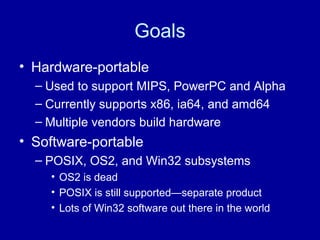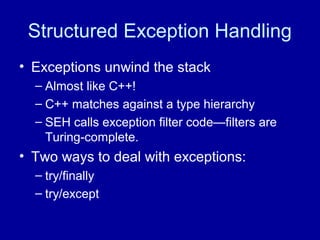the windows opereting system
- 2. Goals • Hardware-portable – Used to support MIPS, PowerPC and Alpha – Currently supports x86, ia64, and amd64 – Multiple vendors build hardware • Software-portable – POSIX, OS2, and Win32 subsystems • OS2 is dead • POSIX is still supported—separate product • Lots of Win32 software out there in the world
- 3. Goals • High performance – Anticipated PC speeds approaching minicomputers and mainframes – Async IO model is standard – Support for large physical memories – SMP was an early design goal – Designed to support multi-threaded processes – Kernel has to be reentrant
- 4. Process Model • Threads and processes are distinct • Process: – Address space – Handle table (Handles => file descriptors) – Process default security token • Thread: – Execution Context – Optional thread-specific security token
- 5. Tokens • “Who you are”—list of identities – Each identity is a SID • Also contains Privileges – Shutdown, Load drivers, Backup, Debug… • Can be passed through LPC ports and named pipe requests – Server side can use this to selectively impersonate the client.
- 6. Object Manager • Uniform interface to kernel mode objects. • Handles are 32bit opaque integers • Per-process handle table maps handles to objects and permissions on the objects • Implements refcount GC – Pointer count—total number of references – Handle count—number of open handles
- 7. Object Manager • Implements an object namespace – Win32 objects are under BaseNamedObjects – Devices under Device • This includes filesystems – Drive letters are symbolic links • ??C: => the appropriate filesystem device • Some things have other names – Processes and threads are opened by specifying a CID: (Process.Thread)
- 8. Standard operations on handles • CloseHandle() • DuplicateHandle() – Takes source and destination process – Very useful for servers • WaitForSingleObject(), WaitForMultipleObjects() – Wait for something to happen – Can wait on up to 64 handles at once
- 9. Security Descriptors • Each object has a Security Descriptor – Owner—special SID, CREATOR_OWNER – Group—special SID, CREATOR_GROUP – DACL • Discretionary Access Control List • List of SIDs and granted or denied access rights – SACL • System Access Control List • List of SIDs and access rights to be audited
- 10. Access Rights typedef struct _ACCESS_MASK { USHORT SpecificRights; UCHAR StandardRights; UCHAR AccessSystemAcl : 1; UCHAR Reserved : 3; UCHAR GenericAll : 1; UCHAR GenericExecute : 1; UCHAR GenericWrite : 1; UCHAR GenericRead : 1; } ACCESS_MASK;
- 11. Security Use • Objects are referred to via handles • Security checks occur when an object is opened – Open requests contain a mask of requested access rights – If granted to the token by the DACL, the handle contains those access rights • Access rights are checked on use – Just a bit test—very fast
- 12. Object Open evt = OpenEvent(EVENT_MODIFY_STATE, FALSE, "SomeName"); – Finds the event object by name – Walks the DACL, looking for token SIDs – Keeps looking until all permissions are granted – If access is granted, inserts a handle to the object into the process’s handle table, with EVENT_MODIFY_STATE access
- 13. Object Use SetEvent(evt); – SetEvent() requires EVENT_MODIFY_STATE access, and an event object. – The kernel looks up the handle in the process’s handle table. – Checks to make sure that it maps to an event object, and that the granted access bits contain the EVENT_MODIFY_STATE bit. – If all is good, the event is set.
- 14. Object Use WaitForSingleObject(evt) – WaitForSingleObject() requires a synchronization object (like an event) and SYNCHRONIZE access. – evt maps to an event object – SYNCHRONIZE access was not requested when the handle was inserted. – Even if the DACL permits it, the wait fails.
- 15. Types of Objects • Events – State is set or clear. – Can clear when a wait completes (auto-reset) • Mutexes – Can be acquired by a single thread at a time. – Automatically release when owner exits. • Semaphores – Maintain a count – Waits decrement the count
- 16. More objects • Threads, Processes, Timers—like events • Registry Keys – Manipulate data in the registry—centralized store of system configuration info. • LPC Ports – Fast local RPC – Security tokens can transfer over LPC calls • Files
- 17. Files & IO • File objects maintain a current offset, and a pointer to the underlying stream. • Default internal model is asynchronous – Synchronous IO just waits for the IO to complete – Async IO can set an event, or run a callback in the thread which queued the IO, or post a message to an IO completion port. • Each request is an IRP
- 18. IRPs • Maintain state of IO requests, independent of the thread working on the IO • IRPs are handed off through the device stack to their destinations – Threads process IRPs – Initiating thread processes the IRP until a device returns STATUS_PENDING – Subsequent processing can be done in kernel worker threads
- 19. Interrupts IRQL—Interrupt Request Level: 0 => PASSIVE_LEVEL Processor is running threads All usermode code is at IRQL 0 1 => APC_LEVEL; threads, APCs disabled 2 => DISPATCH_LEVEL • Running as the processor: can’t stop! • Can’t take a page fault • Only locks available are KSPIN_LOCKs
- 20. Interupts 3-26 => Device Interrupt Service Routines • Device interrupts are mapped to an IRQL and an interrupt service routine; ISR is called at that IRQL 27 => PROFILE_LEVEL—profiling 28 => CLOCK2_LEVEL—clock interrupt 29 => IPI_LEVEL—interprocessor interrupt • Requests another processor to do something 30 => POWER_LEVEL—power failure 31 => HIGH_LEVEL—interrupts disabled
- 21. Interrupts • Hardware signals an interrupt • Interrupt’s ISR runs at device IRQL – Has to be fast; get off the processor and allow other ISRs to run – Typically queues a DPC, acknowledges the interrupt, and returns • DPC—Delayed Procedure Call – Further processing at DISPATCH_LEVEL – Queues work to kernel worker threads
- 22. IO Completion • Driver calls IO Manager to complete the IRP • IO Manager queues a kernel mode APC to the initiating thread • APC: Asynchronous Procedure Call – Kernel mode APC preempts thread execution – Writes data back to user mode in the context of the thread which initiated the IO – Signals completion of the IO
- 23. IO Cache • Classic: block cache – Page mappings translate directly to blocks on the underlying partition. • Windows: stream cache – Page mappings are offsets within a stream. – IO Cache Manager uses the same mappings. – All cache management (trimming) is centralized in the memory manager – All modifications show up in mapped views.
- 24. Virtual Memory • Sections—another object type – Can be created to map a file – Can also be created off the pagefile – Optionally named, for shared memory • Reservation – Range of VA which will not be handed out for some other purpose • Committed – VA which actually maps to something
- 25. Aside: CreateProcess • Just a user mode Win32 API { NtCreateFile(&file, szImage); NtCreateSection(&sec, file); NtCreateProcess(&proc, sec); NtCreateThread(&thrd, proc); } WaitForSingleObject(proc);
- 26. Virtual Memory • Memory Manager maintains processor- specific page table entry mappings. – Some parts of the address space are shared between processes—for instance, the kernel’s address space and the per-session space. • On a pagefault, mm reads in the data • Pages can be mapped without the appropriate access… what to do?
- 27. Signals • With threads, signals don’t work very well. • Some software designs expect to touch inaccessible memory. – Large structured files – Concurrent garbage collection – SLists • Single global handler has to somehow know about all possible situations.
- 28. Structured Exception Handling • Exceptions unwind the stack – Almost like C++! – C++ matches against a type hierarchy – SEH calls exception filter code—filters are Turing-complete. • Two ways to deal with exceptions: – try/finally – try/except
- 29. try/finally res = AllocateSomeResource(); try { SomeOperation(res); } finally { if (AbnormalTermination()) { FreeSomeResource(res); } } return res;
- 30. try/except try { SomeOperationWhichMayAV(); } except (Filter( GetExceptionCode(), GetExceptionInformation())) { DoSomethingElse(); }
- 31. try/except • GetExceptionCode() – A code indicating the cause of the exception • GetExceptionInformation() – Additional code-specific info – The full processor context • Filter decides what to do – EXCEPTION_EXECUTE_HANDLER – EXCEPTION_CONTINUE_SEARCH – EXCEPTION_CONTINUE_EXECUTION
- 32. Structured Exception Handling • On x86, TEB points to stack of EXCEPTION_REGISTRATION_RECORD – auto structs, pointing to handler code – pushed by function prolog – popped by function epilog • On exception, RtlDispatchException() walks the list. – Runs the filters to figure out what to do – Calls handler functions
- 33. Structured Exception Handling • On x86, there’s some overhead with pushing and popping the registration record • On ia64, there is no overhead – Stack traces are reliable – It’s always possible to look up the handler • Exception handling is very slow – Especially on ia64 • Used only for truly exceptional conditions
- 34. Structured Exception Handling • Used in kernel mode too! – Most user mode access will just work – Still need to validate address ranges & data – Works great for SMP when another thread might be in the middle of modifying the address space – Expected read exceptions are returned as status codes from system calls – Expected writes are returned as SUCCESS – Unexpected => buggy kernel => blue screen
- 35. Top-level Exception Filter • Top frame on each thread defines a catchall exception filter • Top-level exception filter: – Notifies the debugger (if being debugged) – Launches a just-in-time debugger (if set up) – Loads faultrep.dll to report the failure
- 36. Faultrep.dll • faultrep.dll offers to report the failure back to Microsoft • We analyze the failures – A significant number are recognized instantly; we can tell the user what happened and how to fix it. – The others go through the standard triage process; developers analyze the dumps and figure out what happened.
- 37. OCA • 67 million machines running XP • Tens of thousands of drivers • Over 100 drivers on any given machine • One bug in one driver => Crash • A significant number of crashes come from third-party drivers (some of which ship on the CD) • Lots of different problems, though
- 38. Driver Verifier • Controlled by verifier.exe • Special-pool’s allocations – Detects allocation overruns & use after free • Validates some behaviors – IRQL—touching paged memory? – DMA buffers • Can inject failures—useful for testing behavior under sub-optimal conditions
- 39. Stress • Every night, a couple hundred machines run stress on the latest build • Stress exercises filesystems, memory, GUI, scheduler, &c, trying to uncover low- memory handling problems and race conditions • Every morning, the stress test team triages failed machines • Developers debug the failures
- 40. Questions?







































